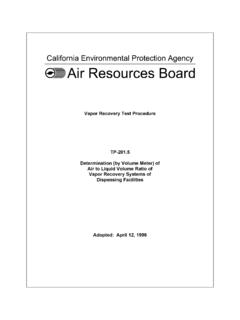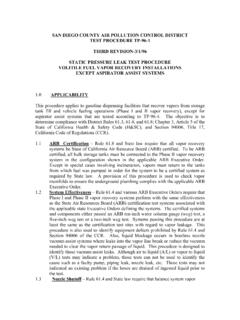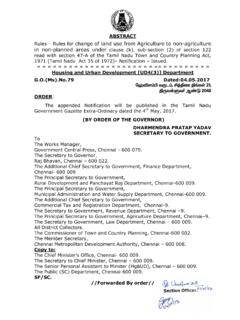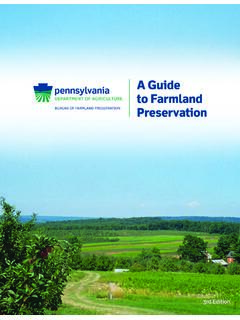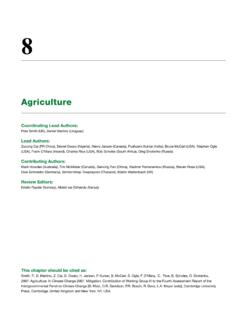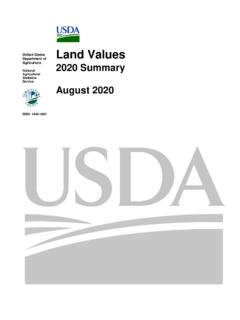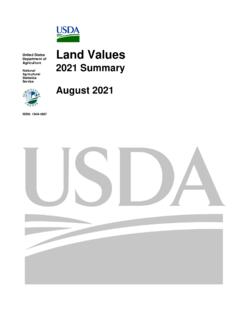Transcription of Guide to Arizona Agriculture
1 Guide to Arizona AgricultureFrom seed funding to sustainable growth, every economy has its roots in Agriculture . The importance of Agriculture and its contributions to the citizens and the state of Arizona cannot be overlooked. Agriculture is estimated to be a $ billion industry, resulting in the creation of 138,000 jobs. Representing three of Arizona s 5 C s cattle, citrus and cotton Agriculture is a fountain of economic opportunity for tens of thousands of Arizonans and a source of sustenance for millions pride in our state s agricultural achievements has no words. Arizona is the 3rd largest producing state for fresh market vegetables, and it is 4th in the country in acres of organic vegetables. Arizona -grown fresh produce shipped 112 million cartons last year. And we re still leaders in making the country shine our beautiful rosebushes will represent 75% of the national market in the near , our state produced million pounds of red meat and more than billion pounds of milk.
2 Arizona takes pride in our farmers and ranchers and is always striving to lessen their regulatory burdens so that citizens can pursue their dreams, expand their operations, and reach for the Grand Canyon State has one of the lowest corporate tax structures, touts a young and healthy work force, and is the national model when other states need new ideas. So, whether a business decides to begin in this great state, expand here, or relocate from somewhere else, Arizona is open for you re looking to learn more about our state s Agriculture industries, find information that can enhance your life, or considering relocating to Arizona , this Guide to Arizona Agriculture is for you. A. Ducey Governor, State of Arizona December 2018 Did you know, Arizona s Agriculture industry generated $ billion to our state s economy and directly and indirectly supported more than 138,000 full and part-time jobs, employing more than 162,000 unique workers?
3 Did you know that Arizona grows some of the best alfalfa, red durum wheat (for pasta) and pecans? Arizona is the second leading producer of cantaloupes, honeydews, pistachios and dates for the you know that Yuma, Arizona is the Winter Salad Bowl capitol of the United States when it provides 90% of all leafy greens to the nation? Did you know Arizona agricultural producers export to over 70 countries?Not only does Agriculture supply our food, it s vital to the Arizona economy, and provides open space, wildlife habitat and efforts to protect and conserve our natural resources. As Thomas Jefferson stated, Agriculture is our wisest pursuit because it will in the end contribute most to real wealth, good morals and happiness. A large part of the Arizona Department of Agriculture s (AZDA) mission is to support and promote Agriculture in this great state. We take that job seriously. If you are interested in learning about Arizona Agriculture , we can Guide to Arizona Agriculture provides you with a well-rounded perspective into Arizona Agriculture and illustrates how vital it is to society.
4 Contact the AZDA at to learn more about Agriculture and the ,Mark W. Killian Director, AZ Dept of Agriculture December 2018 Open for Business 6 Water in the Desert 7 Arizona Agriculture 8 Indigenous Farmers 10 Arizona Farm Bureau 13 Arizona Beef Council 14 Arizona Cattlemen s Association 15 Dairy Associations 16 Egg Producers 17 Agribusiness & Water Council of Arizona 18 Arizona Leafy Greens 19 Western Growers 20 Yuma Fresh Vegetable Association 21 Arizona Wine Growers Association 22 Arizona Pecan Growers Association 23 Arizona Nursery Association 24 Arizona Cotton Growers Association 25 Arizona Grain Research & Promotion Council 26 Education 28 Cooperative Extension 30 Youth 31 Food Safety 32 Arizona Harvest Schedule 34 Exports 37 Department 38 Partners 40 Contents6 The Grand Canyon State boasts natural beauty and wonderful weather. It also provides an excellent climate for business. Located in the Southwest, Arizona has access to international and interstate markets, many within a day s drive.
5 The competitive tax structure and available workforce add to the benefits for Arizona well-planned infrastructure provides quick access for products to quickly go to market, as well as for supplies to come into the state. Arizona offers more than 66,000 milesof highways, over 40 public transit systems, two Class I railroads and more than 80 airports. Companies have access to 65 million consumers through the transportation system. The state s location gives proximity to some of the world s largest economies Texas, Mexico and California as well as shipping ports on the West has one of the lowest corporate tax structures in place at the rate of find tax credit programs for manufacturing, research and development, renewable energy and the creation of quality jobs. Quality jobs are defined by the areas in which the business locates, based on average wages and health state s workforce tops 3 million and has a relatively young median age of 37.
6 It is a Right to Work state and has some of the lowest labor costs in the a business decides to start, expand or relocate, Arizona is Open for for Business7 There are four deserts in the Grand Canyon State leading many people to believe there is no available water in the state. Truthfully, Arizona acknowledged the water situation decades ago and planned for growth and protected its water resources. The state is blessed with a network of rivers and streams including the Colorado, Verde, Salt, Gila, San Pedro, Santa Cruz and Little Colorado Rivers. There are also many tributaries that contribute to those rivers. Each watershed connects communities that are dependent on their flows for sustaining life and past provides a foundation for efficient use and conservation of water. The Hohokam and other indigenous people used canals to divert water for crops and sustain communities. Modern water leaders work to share the water among various users: agricultural, municipal, industrial, tribal and environmental users.
7 Leaders at all levels of government and the private sector have taken action for the sustainable use of Arizona s water supply. Other efforts provide storage capabilities above and below ground in an effort to save for future uses water the same way it uses the land . Modern technology helps farmers and ranchers use what they need and no more. Water not used in the fields returns to the rivers and storage. Most importantly the water used by Agriculture is not wasted; it provides food and fiber to the people of Arizona , the United States and many other countries. Water in the Desert8 Long before Arizona was a state, and before there was a United States, Agriculture thrived in the region. Agriculture s history in the Grand Canyon State stretches back more than 4,000 years. Archaeological records show Indigenous people growing gardens to sustain their explorers traveled through the state in the early 19th century, they found people growing corn, wheat, barley and raising cattle.
8 They also found one of the most amazing irrigation systems, one that is still used today. The Hohokam people built the canals to move water from the Gila and Salt Rivers to their fields. The canals were engineered to move the water at the correct speed to maintain the flow, without clogging the canals with silt and then, producers have found the diversity of Arizona s climate and soil supports hundreds of food crops, beautiful landscaped plants, poultry, swine and cattle for dairy and meat. Arizona Agriculture exports vegetables, fruit, nuts, seeds, wheat, hay, cotton, eggs, beef and milk to 70 countries and across the , Agriculture in Arizona contributes more than $ billion to the state s economy. One study puts the number of jobs supported by Agriculture at approximately 138,000, and the number of workers employed at 162,000. Arizona Agriculture9 Some of the many people that make Agriculture work in Arizona include field workers, harvest crews, distributors, farmers, ranchers, fertilizer and pesticide suppliers, scientists, engineers, fuel companies and equipment s climate provides year-round growing for hundreds of types of crops.
9 Besides crops such as cotton, alfalfa and wheat, Arizona farmers raise numerous specialty crops. The specialty crop sector includes thousands of varieties from nursery plants to the fresh vegetables eaten every day. Leafy greens, cabbage, dates, melons, lemons, oranges, apples, potatoes and tomatoes are just some foods harvested from Arizona s nourishing state also boasts a growing nut and date crop industry. Pistachio trees have a small presence in the Grand Canyon State, but the pecan business is developing quickly. The state has the largest pecan grove in the country and the largest date plantation in the animal industry, led by cattle ranching, dairy and dairy production, is the largest agricultural sector. The egg industry is growing as companies see the excellent economic opportunities. There are also facilities licensed for growing fish and FarmersIndigenous farmers predate Arizona statehood by several hundred years, with some areas going back centuries.
10 The United States Department of Agriculture National Agriculture Statistics Service s census from 2012 paints a picture of indigenous farming and ranching. Currently there are 18,475 indigenous farmers and ranchers operating in Arizona making up 57% of the agricultural operations in the state. They operate on over million acres producing over $ million in direct agricultural largest use of the agricultural land is used for animals including beef cattle, sheep, goats, fish and other animal products. They grow a variety of crops including, but not limited to alfalfa, hay, corn, cotton, wheat, citrus, olives and potatoes. The average age of an indigenous producer is 58, virtually the same as their non-native counterparts. Unlike the rest of the state, women make up the largest number of indigenous > The Arizona Farm Bureau was organized in 1921 to represent all Agriculture : small, medium and large, animal, and organic, conventional and biotech farmers and ranchers.
